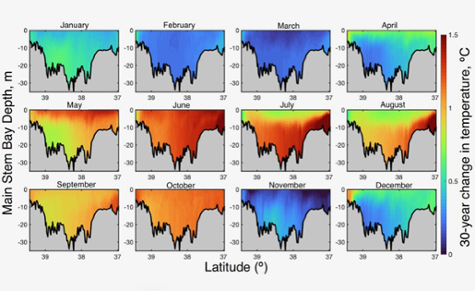VIMS study reveals extent, seasonality and causes of Chesapeake Bay warming
Long-term measurements of water temperature clearly show Chesapeake Bay is warming. A new study by researchers at William & Mary’s Virginia Institute of Marine Science updates that trend, reveals a clear seasonal pattern, and quantifies the relative contributions to warming brought by the atmosphere, Bay tributaries, and the ocean.
A better understanding of the seasonal timing and causes of Bay warming will improve projections of future conditions and help managers better assess water-quality goals, particularly as they relate to efforts to limit low-oxygen “dead zones,” which can stress mobile animals such as striped bass, and kill attached or slow-moving invertebrates outright. Concerns regarding the impact of warming on Bay health and restoration goals were emphasized earlier this month when the Chesapeake Bay Executive Council signed a new directive for collective action to address the threats of climate change in all aspects of the partnership’s work.
Lead author of the new study, published in the Journal of the American Water Resources Association, is VIMS PhD student Kyle Hinson. His co-authors are VIMS scientists Dr. Marjy Friedrichs and Dr. Pierre St-Laurent, fellow PhD student Fei Da, and Dr. Ray Najjar of Pennsylvania State University. Their results are based on a combination of field measurements and computer modeling. The field data include monthly records of Bay water temperatures stretching back more than three decades, along with long-term records of river flow, weather conditions, and ocean temperatures used to prime the model and verify its simulations.
“During the last three decades,” says Hinson, “the Bay has warmed three to four times faster in summer than winter. These changes have been driven primarily by atmospheric warming, but in Virginia waters ocean warming has contributed as well.” Surface and bottom waters are generally warming at a similar rate throughout the Bay, except for a slightly elevated rate of bottom warming in the saltier waters near its mouth. Overall, the team’s findings show that the Bay’s summertime bottom waters, where hypoxia is of greatest concern, have warmed at a rate of 0.07° F annually since 1985, with a total warming of 2°F between the late 1980s and the late 2010s.
The team’s modeling experiments show that almost 90% of Bay warming is driven by atmospheric effects—warming air temperatures and the increase in heat energy emitted back to the Earth from the atmosphere due to greater concentrations of greenhouse gases. Sea-level rise has slightly tempered summer warming (as the Bay becomes deeper it takes longer to both warm in the spring and cool in the fall), and the influence of warming due to river flow has been limited to the heads of tidal tributaries. The influence of ocean warming is greatest near the Bay mouth, where it accounts for more than half of summer warming in bottom waters.
Why timing and cause matter
The team’s discovery of the seasonality and causes of Bay warming offer valuable perspectives on its likely impacts and the most effective management responses and monitoring approaches.
“Elevated rates of warming during our yearly summertime peak in hypoxia and anoxia are particularly concerning,” says Friedrichs, “as water’s capacity to hold oxygen decreases with increasing temperature.” The researchers calculate that their estimate of warming within the Bay’s bottom waters—an increase of roughly 2.0° F since 1985—has led dissolved oxygen levels to decrease by at least 0.1–0.2 mg/L during that span.
The warming-related drop in dissolved oxygen contributes to the decrease caused by human inputs of excess nutrients, which fuel algal blooms that suck oxygen from the water when the algal cells die, sink, and decay. Continued warming will thus challenge recent successes in reducing nutrient inputs and dead-zone conditions due to the Chesapeake Bay Program’s restoration actions.
Given the greater loss of oxygen due to warming bottom waters, Friedrichs says “It’s highly likely that additional nutrient reductions will be necessary in the future to mitigate the impacts of temperature increases throughout the Bay.”
The authors also stress that future rates of Bay warming will depend not only on global atmospheric trends, but on regional changes in ocean circulation, which scientists have linked to an observed increase in temperatures within the coastal waters of the mid-Atlantic just outside the Bay mouth. These waters are currently warming at a rate of 0.4°F per decade, around two times faster than atmospheric temperatures, and nearly four times greater than the increase in globally averaged surface ocean temperatures.
Future warming of the Bay’s bottom waters may thus largely depend on additional changes in ocean conditions, which themselves depend not only on the rate of additional heat uptake but also changes in the position of the Gulf Stream and Labrador Current.
Friedrichs says “We found the greatest increase in bottom temperatures in the areas of the Bay most influenced by the ocean—the saltier Virginia waters near the Bay mouth. This suggests these would be ideal locations for deploying long-term monitoring instruments to detect future changes in Bay temperature, which would also help us better estimate the extent of Bay hypoxia.”















